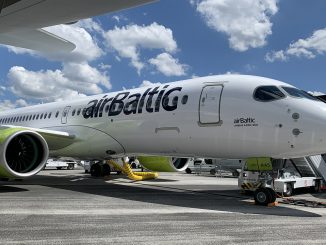
SAS Scandinavian Airlines has unveiled its brand new aircraft livery on Thursday.
The new scheme was presented on a computer rendering of an Airbus A350, instead of a real aircraft – which would have been what most airlines do with new livery announcements.
SAS will now begin to paint its entire fleet of more than 150 airplanes in the new design, with the Airbus A320neo and the airline’s soon-to-be-delivered first A350-900 being the first two types. By 2024, every aircraft in SAS’ fleet will feature the new livery.

The new color scheme features a number of changes, compared to the previous livery, but remains all typical design features of the SAS brand – except for the red engines.

The engines are now painted in silver with a blue ‘ring’ in the front. The word ‘Scandinavian’ remains, but is now in dark grey, instead of the previous white on red.
Another change is the blue ‘tail’. SAS had previously only painted the vertical stabilizer in blue with white letters on it. The blue paint now goes down to the ‘belly’ of the aircraft, picking up a very familiar scheme used by many other airlines these days. You can’t avoid noticing the similarity to SAS’ alliance partner Lufthansa, which refreshed its own livery in early-2018.

The airline seems to set a focus on ‘SAS’ as its main branding, with new titles on the forward section of the aircraft. These huge, silver letters – or what SAS calls them: “proud and confident” – are replacing ‘Scandinavian Airlines’, a name it had previously often identified itself with. However, a big ‘Scandinavian’ is now painted under the fuselage – so that no one forgets where the carrier is from.

SAS says the livery now features a “fresher shade of grey” on the fuselage. It is hard to tell how much different it will end up looking, as the carrier is only showing of computer renderings of the livery for the time being. Fact is, other than almost all airlines in the skies, SAS will continue to use a different color than complete white on its aircraft.

The airline states it has chosen an “advanced coating material” for the new livery, which reduces the number of required layers and therefore also the weight of the airplane wearing it, resulting in a minor decrease in fuel use and CO2 emissions. This paint with an “increased durability” is provided by AkzoNobel, a multinational paint company based in The Netherlands, with a revenue more than twice that of SAS.

Jakob Wert is an aviation journalist from Germany. He built up the website IFN.news and is the Editor-In-Chief of International Flight Network.



